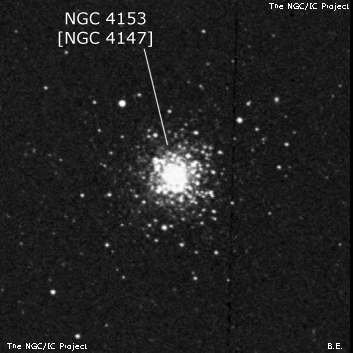
NGC 4147 is the New General Catalogue identifier for a globular cluster of stars in the northern constellation of Coma Berenices. It was discovered by English astronomer William Herschel on March 14, 1784, who described it as "very bright, pretty large, gradually brighter in the middle". With an apparent visual magnitude of 10.7, it is located around 60,000 light years away from the Sun at a relatively high galactic latitude of 77.2°.This is a relatively small globular cluster, ranking 112th in luminosity among the Milky Way globular cluster population. It is considered an Oosterhoff type I cluster (OoI), despite having a relatively low metallicity. Indeed, it has the lowest metallicity of any OoI cluster known. There are 19 RR Lyrae variable star candidates and as many as 23 blue stragglers. A high proportion of the latter are concentrated near the dense core of the cluster, which is consistent with the idea that blue stragglers form through stellar mergers.The cluster lies some 70.4 ± 7.5 kly (21.6 ± 2.3 kpc) from the Galactic Center, and is relatively isolated from other globular clusters in the galaxy. The position of this cluster makes it a candidate for association with the Sagittarius tidal stream, and thus it may have been captured by the Milky Way after separation from the Sagittarius Dwarf Spheroidal Galaxy. A contour map of the cluster appears to show S-shaped tidal arms stretching to the north and south for several tidal radii. Such features are predicted for globular clusters that follow elliptical orbits and are near their apogalacticon.
400/500mm - 17.5" (4/13/96): moderately bright, fairly small, irregular 2'-2.5' diameter, very small bright core. A few faint stars are resolved at 220x including one brighter star at the south edge. Appears on the verge of more extensive resolution. At 280x, the halo clearly has an irregular outline and several stars are resolved in extensions or star lanes. The core is mottled and intense but not resolved.
17.5" (3/20/93): fairly bright, moderately large, round, 2.5' diameter. Approximately six faint stars are just resolved around the edges of the halo including a single easy mag 14 star at the SSW edge. The compact core is mottled and clumpy but has no clean resolution. There is an impression of several star lanes in the halo just below the limit of resolution.
900/1200mm - 48" (4/22/17): NGC 4147, a class IX globular, was well resolved and impressive at 488x. It appeared very bright, fairly large, large bright core. Over 100 stars were resolved including a number of relatively bright 14.5-15.5 stars. The stellar density increases significantly towards the center where a large number of resolved stars are packed over a hazy, mottled background. The loose halo was well resolved, a bit scraggly around the edges and extended to ~5' diameter. The superthin galaxy UGC 7170 lies 18' NNE.